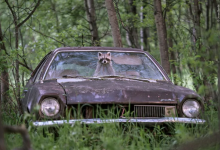Art restoration expert unveils secrets behind old paintings at the ROM
Heidi Sobol is a detective of the art world, uncovering the hidden secrets behind paintings. But the tool she’s using isn’t high-tech: it’s a shish kabob stick with some cotton wrapped around one end.
Sobol, the senior paintings conservator at the Royal Ontario Museum, sits in front of a painting on an easel and dips her super-sized Q-tip into a solution of mostly water with a bit of soap-like mixture, as she begins the slow, methodical work she’ll do for hours.
It’s a step up from the cleaning method Sobol used at the beginning of her career.
“I trained on cleaning paintings with saliva,” she laughs, explaining that the salt in our own spit is a great cleaning agent.
“We’ve got other ways now to use science a little more strategically.”
Sobol spoke to CBC Toronto just days before the opening of the ROM’s critically acclaimed exhibit In the Age of Rembrandt, a stunning collection of 70 paintings by Rembrandt and other Dutch masters of the 17th century.
The paintings are being uncrated Thursday, so Sobol and her ROM colleagues can prepare them for the exhibit’s opening on June 1. She’ll be checking their condition before they’re put on display.
But for now, Sobol is working on something a lot less famous: a painting of an altar boy from the early 20th century. She chooses a little section of the artwork and gently rolls the cotton over it, her giant Q-tip becoming more and more brown with dirt and grime as she goes.
It’s the behind-the-scenes job at every museum before paintings in seemingly immaculate condition hang on the wall in an exhibit.
“It’s not simply just opening up a jar of cleaning solution or varnish and then applying it,” Sobol said, adding that people in her position need to know how to solve complex problems.
“You need to understand how things are interacting,” she says, adding that she needs a solid understanding of organic chemistry along with an art background, to prevent small mistakes from turning into a possible disaster, changing precious works of art.
Some days, she uses a microscope to zoom in on paintings.
Today, though, in her workshop in a backroom at the ROM, she dips down, craning her neck upward, to see the painting in front of her at another angle.
This piece was painted in approximately the 1920s, donated by one of the altar boy’s descendants.
Almost 100 years ago, the boy would have posed for hours, standing in his red and white robe in front of the painter.
The finished painting sat for many years in a home in Elliot Lake, Ont., becoming brown and discoloured.
Sobol looks at the brownish colour on her cotton swab and guesses people smoked in the home.
As she continues her slow, solitary scrubdown, it doesn’t take long for her to see what it may have looked like originally.
“I’m seeing, like, greys and blues, a little bit of lavender. A lot of that was obscured,” she said.
Sometimes, she has more dramatic finds: uncovering the artist’s signature or bringing back a painting damaged in a fire or flood.
“It’s the greatest feeling to be able to pick up the phone and say, ‘You may have thought this painting was lost, but I can assure you, we can recover this,'” she said.
She spies another possible discovery in the painting she’s working on, as she watches the little boy’s robe turn a brighter red.
“I’m betting that this hand was moved,” she said, pointing out a difference in the brush strokes, a possible last-minute change by the artist, common in paintings.
She says she may spend 40 hours working like this on a painting, possibly double that, depending on the piece.
And with portraits, like this one, there’s a relationship that develops in her workshop, especially once she starts working on the face.
“When they’re staring at you, I think that’s when things start to get a little more personal,” she says, as she starts to wonder what the subject may have been thinking.
“You start to understand their expressions, because you’re staring at it constantly,” she explains.
But after years of sitting so close to paintings, she can’t see artwork in the same way she used to.
“I miss the day when I would go into an art museum or an art gallery and simply enjoy the brushwork,” Sobol laughs.
“Instead I’m, you know, looking at the saturation levels of the varnish.”








Redes Sociais - Comentários